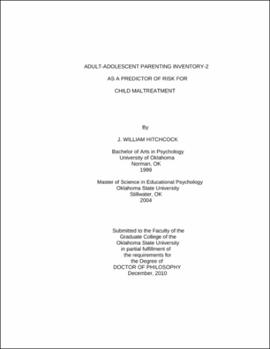| dc.contributor.advisor | Montgomery, Diane | |
| dc.contributor.author | Hitchcock, J. William | |
| dc.date.accessioned | 2013-11-26T08:34:33Z | |
| dc.date.available | 2013-11-26T08:34:33Z | |
| dc.date.issued | 2010-12 | |
| dc.identifier.uri | https://hdl.handle.net/11244/7434 | |
| dc.description.abstract | Scope and Method of Study: | |
| dc.description.abstract | The purpose of this study was to investigate the Adult-Adolescent Parenting Inventory (AAPI-2) as a predictor of level of risk for child maltreatment as determined by the Department of Human Services (DHS) safety assessment. The AAPI-2 consists of five scales. The scales are inappropriate parental expectations, empathy, value of corporal punishment, family role reversal, and restrict power and independence. Archival data from a community education program for CPS referred parents was used in the study. The archival data consisted of 341 records of adult participants in the program. Predictive discriminate analysis was performed to investigate the ability of the AAPI-2 to predict risk as determined by DHS safety assessments. Exploratory investigation of influences of various demographics on the AAPI-2 composite score and on level of risk utilized multiple regression and discriminate analysis techniques. | |
| dc.description.abstract | Findings and Conclusions: | |
| dc.description.abstract | Results indicated significant results put poor model fit for the AAPI-2 in correctly classifying level of risk for maltreatment as determined by the DHS safety assessment. The exploratory analysis found gender to predict scores on the AAPI-2, p < .05. There were no significant findings related to demographics and prediction of level of risk for child maltreatment, although strong associations for education level, income level, and experiences of family violence. Implications of the results point to the need for future research to investigate the structure of the AAPI-2. Demographics of low income and experience of family violence both support previous research in their association with child maltreatment. Results indicate that in practice the use of the AAPI-2 with populations involved with child welfare services should be done so with caution. | |
| dc.format | application/pdf | |
| dc.language | en_US | |
| dc.rights | Copyright is held by the author who has granted the Oklahoma State University Library the non-exclusive right to share this material in its institutional repository. Contact Digital Library Services at lib-dls@okstate.edu or 405-744-9161 for the permission policy on the use, reproduction or distribution of this material. | |
| dc.title | Adult-adolescent parenting inventory-2 as a predictor of risk for child maltreatment | |
| dc.contributor.committeeMember | Bull, Kay | |
| dc.contributor.committeeMember | Harrist, Steve | |
| dc.contributor.committeeMember | Fuqua, Dale | |
| osu.filename | Hitchcock_okstate_0664D_11202.pdf | |
| osu.accesstype | Open Access | |
| dc.type.genre | Dissertation | |
| dc.type.material | Text | |
| dc.subject.keywords | aapi-2 | |
| dc.subject.keywords | child maltreatment | |
| dc.subject.keywords | child protective services | |
| thesis.degree.discipline | Teaching and Curriculum Leadership | |
| thesis.degree.grantor | Oklahoma State University | |
